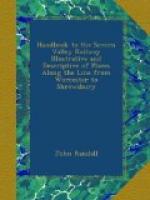Although the Severn Valley Railway joins the Main Trunk line at Hartlebury, Worcester is regarded as its proper terminus; and at that point we commence our description.
WORCESTER.
[Illustration of Worcester: 4.jpg]
Population, 31,123. Returns two Members to Parliament
Market days—Wednesdays and Saturdays Fair days—Saturday before Palm Sunday, Saturday before Easter Day, August 15th, September 19th, and first Monday in December.
Our engraving represents the “faithful city” as it appears from a point between the bridges, with the Cathedral rising from an eminence above the river. The venerable pile was raised by the brave and pious bishop Wulstan, upon the site of an earlier edifice, formerly the church of a priory founded by one of the Saxon kings. Recent restorations, carried on under the direction of the Dean and Chapter, have led to the correction of defects, resulting from time, and ignorance on the part of past builders, and have disclosed features which add much to the grandeur of the edifice; so that in addition to impressions its magnificence creates upon the mind of the general visitor, it now affords a rich treat to all who delight to trace the boundary lines of ecclesiastical architecture, as they approach or recede from the present time. First, there is the Norman or Romanesque of the period of its erection, of which the crypt and part of the central transept are specimens; secondly, the First Pointed or Early English, as seen in the eastern transept; thirdly, the Middle Pointed or Decorated, as in the tower, guesten hall, and refectory; and, fourthly, the Third Pointed or Perpendicular, as in the north porch, in the cloisters, and Prince Arthur’s Chapel. Amongst ancient mural monuments, covering the dust or commemorating the virtues of the great, will be found King John’s tomb, in the centre of the choir; one in white marble of Prince Arthur; and those of bishops Sylvester, Gauden, Stillingfleet, Thornborough, Parry, and Hough, the latter a chef d’oeuvre of Roubilliac’s; also that of Judge Lyttleton, “the father of English law;” and others of men renowned for learning, piety, or bravery. Near this fine old ecclesiastical edifice once stood the feudal stronghold that protected it, the only remaining portion of which is a crumbling mass of stone known as Edgar’s Tower. From standing in the college precincts it is sometimes mistaken for a portion of the cathedral; it is, however, a relic of the old castle, the keep of which rested on a mound of sand and gravel, which was found to contain, upon its removal in 1833, Roman remains of the reigns of Augustus, Nero, Vespasian, and Constantine. In High Street, leading from the Cathedral to the Cross, is the Guildhall, erected from a design by a pupil of the great Sir Christopher Wren, and considered to be one of the most handsome brick-fronted structures in the kingdom. It is decorated with statues




